Mystery Foto #88 Solved: The Homecoming of Charles Lindbergh to Roosevelt Field on June 16, 1927
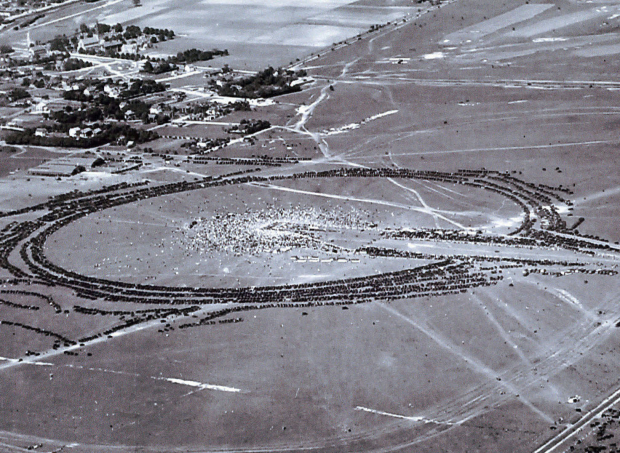
This weekend's Mystery Foto documented a historic Long Island event.
Answers to Mystery Foto questions:
-What was the historic event captured in this aerial?
The homecoming of Charles Lindbergh to Roosevelt Field , 27 days after becoming the first person to cross the Atlantic non-stop solo in an airplane.
-What was the date of the aerial?
June 16, 1927. Lindbergh had flown from Bolling Field, Washington, DC to Roosevelt Field (2 hours and 35 minutes). He then flew from Roosevelt Field to nearby Mitchel Field (5 minutes).
-How was the Motor Parkway related to this photo?
The Motor Parkway is the road in the lower corner of the Mystery Foto. Many of the cars in the circle arrived via the Motor Parkway.
-Which golf course can be seen in the aerial?
Salisbury Links, now part of the Eisenhower Park golf courses.
Congrats to Steve Lucas, Tim Ivers, Greg O., Sam Berliner III, Arthur Emerson, Art Kleiner, Bob Albertson for correctly identifying the event. Kudos to Steve Lucas, Greg O., Arthur Emerson and Art Kleiner for correctly answering every Mystery Foto question.
Enjoy,
Howard Kroplick
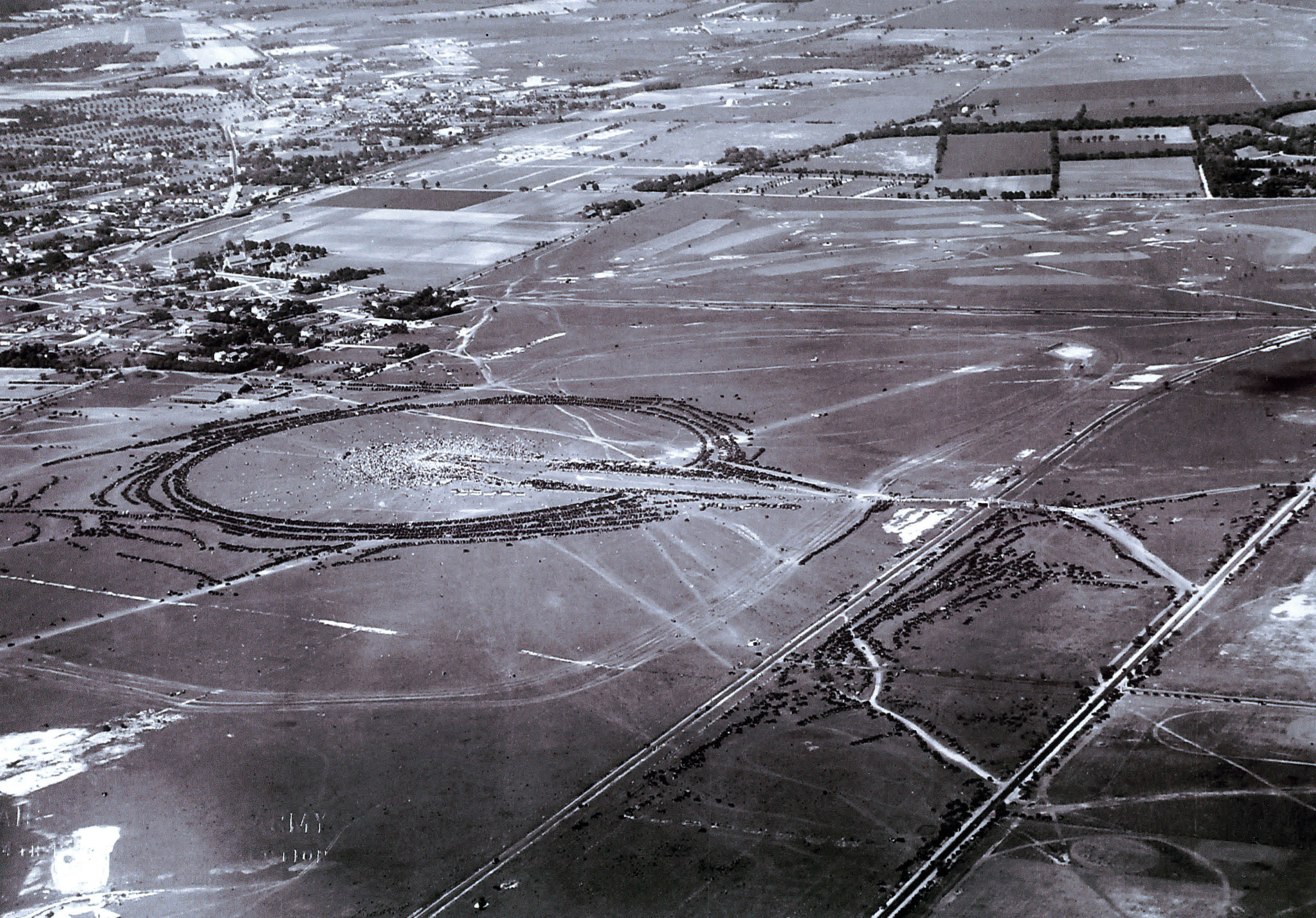
One of the busiest days on the Motor Parkway was June 16, 1927, when Charles Lindbergh returned to Roosevelt Field to celebrate his successful solo flight to Paris. Lindbergh had taken off from the Roosevelt Field east runway 27 days earlier. The Motor Parkway is the road in the middle of the image running parallel to Stewart Avenue on the right. The Roosevelt Field Motor Parkway Bridge can be seen in this aerial.
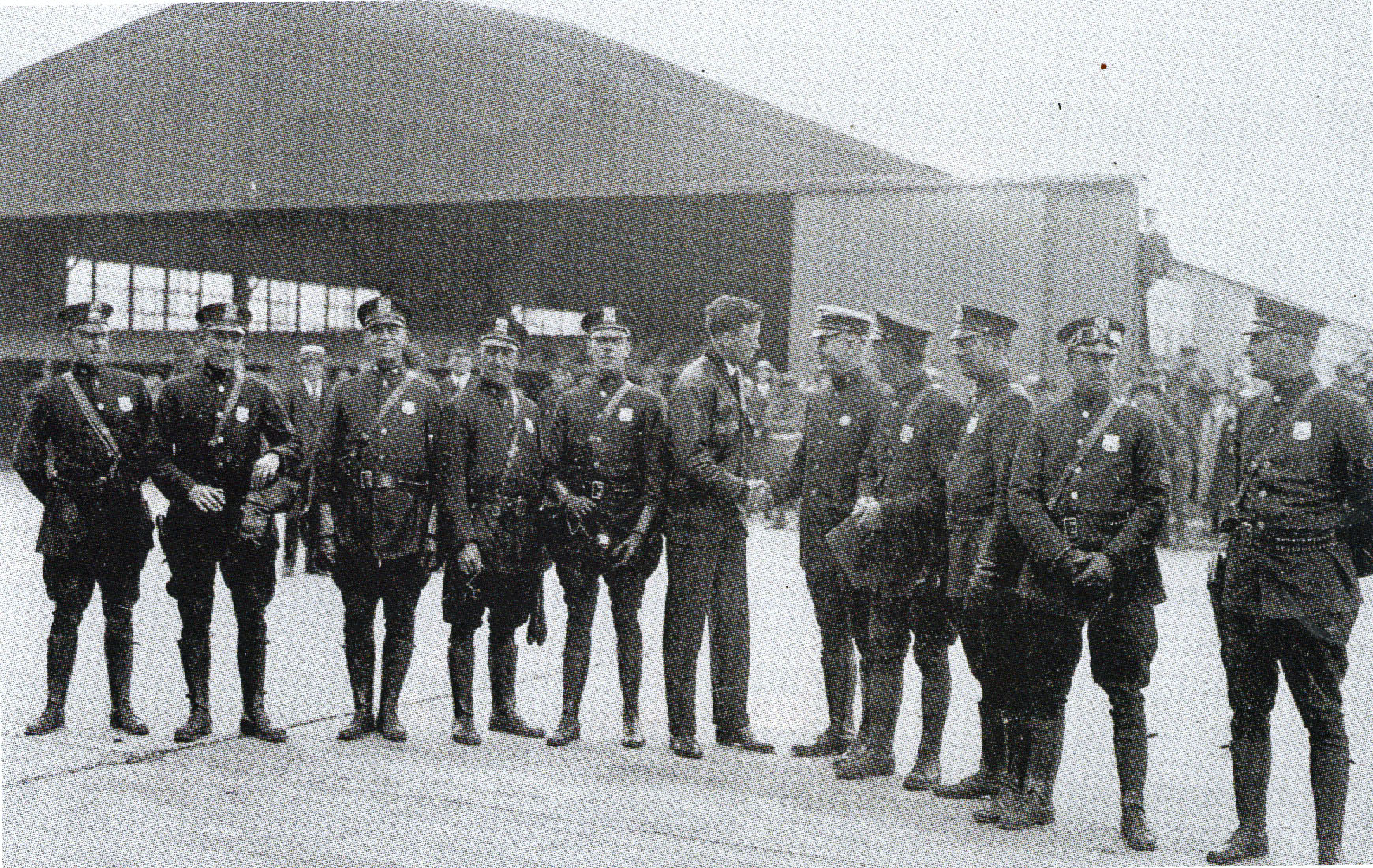
Members of the Nassau County Police Department motorcycle division congratulate Lindbergh on June 16, 1927.
I believe the hangar in the background was located at Mitchel Field. The police escorted Lindbergh to nearby Roosevelt Field for the 3:30 pm ceremony.
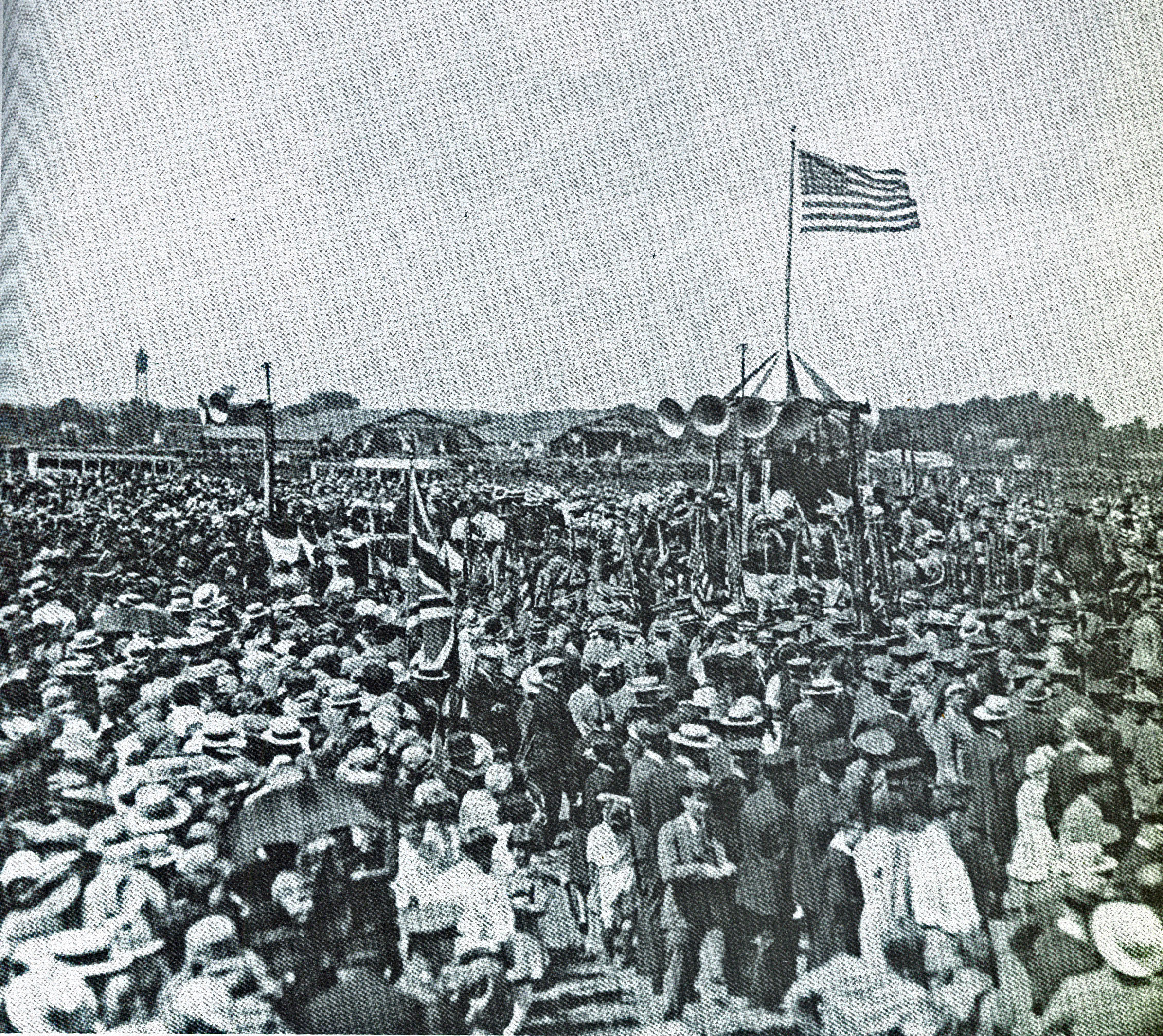
An estimated crowd of over 25,000 people greeted Colonel Lindbergh.
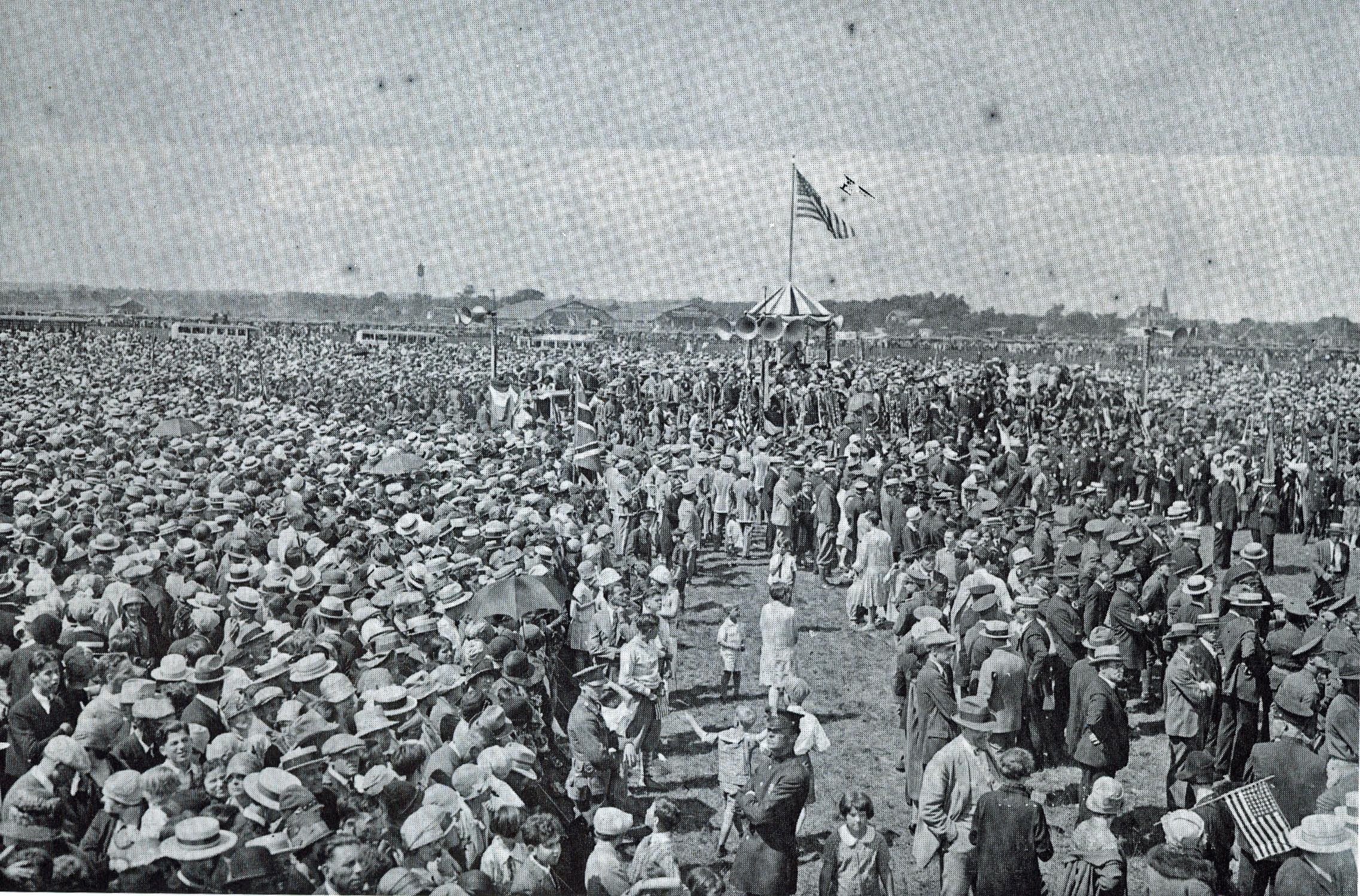
In one of the hangars in the rear was the America that was flown by Commander Richard Byrd and his crew of four across the Atlantic 13 days later. After a flight of over forty hours, the airplane managed to arrive over Paris, but was unable to land due to heavy fog, even after 6 hours (and, at observers reported, nearly hitting the Eiffel Tower). They flew the plane 150 miles west and forced a water landing 300 years off a Normandy shore.

At the homecoming celebration in the center of the circle, Colonel Charles Lindbergh addressed the crowd and promoted the development of Roosevelt Field as a major aviation center. "If we are to take our place among the nations of the world in aviation, then New York must set the example."
The gentleman to left of Lindbergh was Colonel Theodore Roosevelt, Jr., the son of President Theodore Roosevelt.
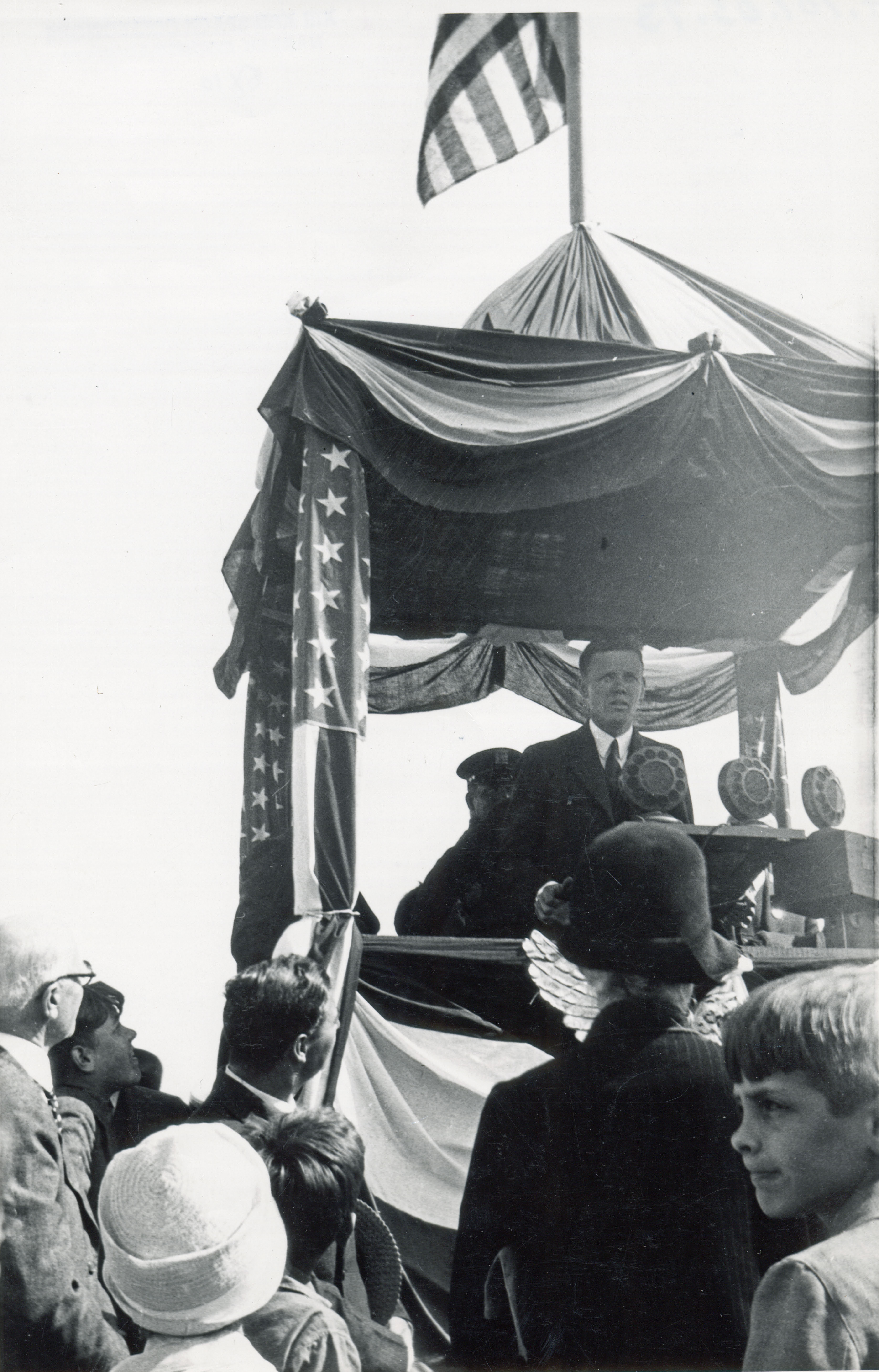
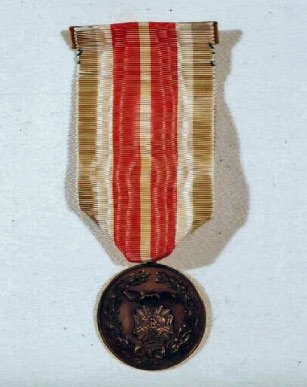
Special Medal of Honor Presented to Presented to Charles Lindbergh by the Veterans of Foreign Wars
Medal presented to Charles Lindbergh by State Commander Green of the New York chapter of the Veterans of Foreign Wars, on June 16, 1927 at Roosevelt Field, NY. Col. Theodore Roosevelt spoke and introduced Lindbergh. This reception followed the Brooklyn reception and Knights of Columbus luncheon upon New York's Welcome Home celebration. 14K gold special medal of honor; obverse has VFW insignia with propeller above; reverse has inscription; red, white and blue striped ribbon attached to bar pin; accompanied by a scroll.; reverse has inscription 1981.67.27 Ribbon fragment with 2 red, 2 blue, and 3 white stripes, presented by the VFW, State of New York, Old Number 27.44.p3.25, Gathered by Louise O. Knight.
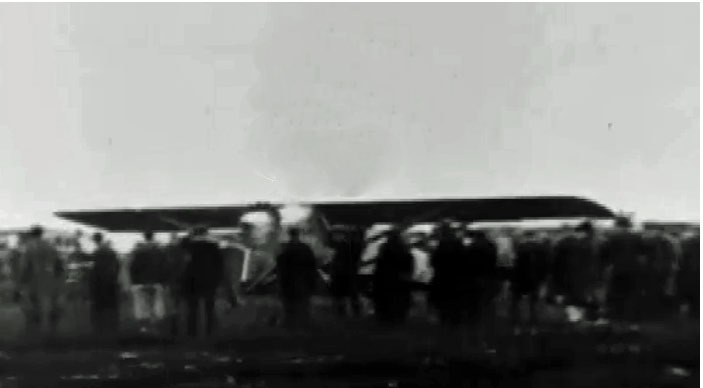
Will Perkins, a real estate appraiser who specializes in airport properties, has assembled news footage of the takeoff from Roosevelt Field on his website. Part 3 of his Lindbergh series shows the takeoff and the Spirit of St. Louis barely making it over the telephone wires on Merrick Avenue. Watch all four parts of Will Perkins' film for the story of Lindbergh's flight.
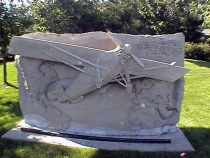
This Lindbergh monument is located at the parking garage of the Source Shopping Mall in Westbury. It is very close to where the Spirit of St. Louis left the ground. The monument was designated a Town of Hempstead landmark in 2013.
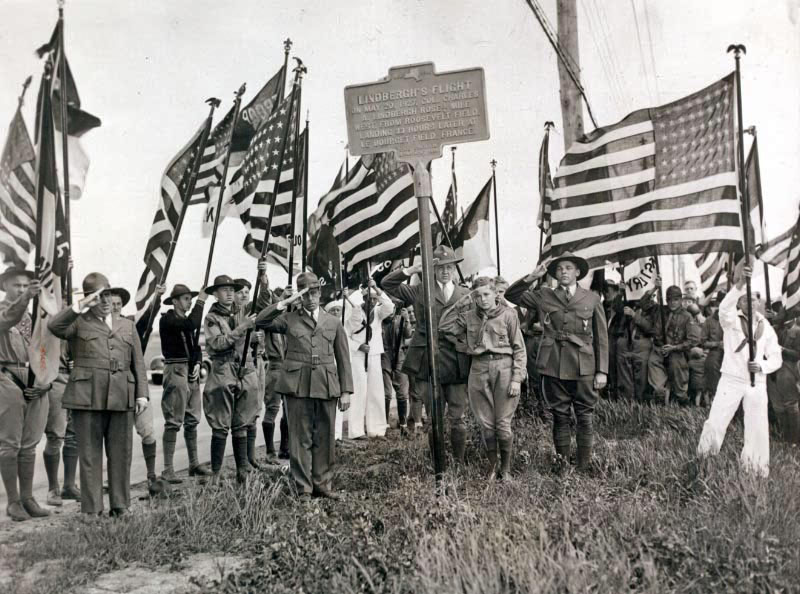
This historical marker Lindbergh's Flight was placed by New York State on the west side of Merrick Avenue where the Spirit of St. Louis just cleared the telephone wires The marker was placed approximately midway from the Merrick Avenue Motor Parkway Bridge and Old Country Road.
In the 1990s, this marker was stolen from the site. in 1937, this ceremony marked the tenth anniversary of Lindbergh's flight.
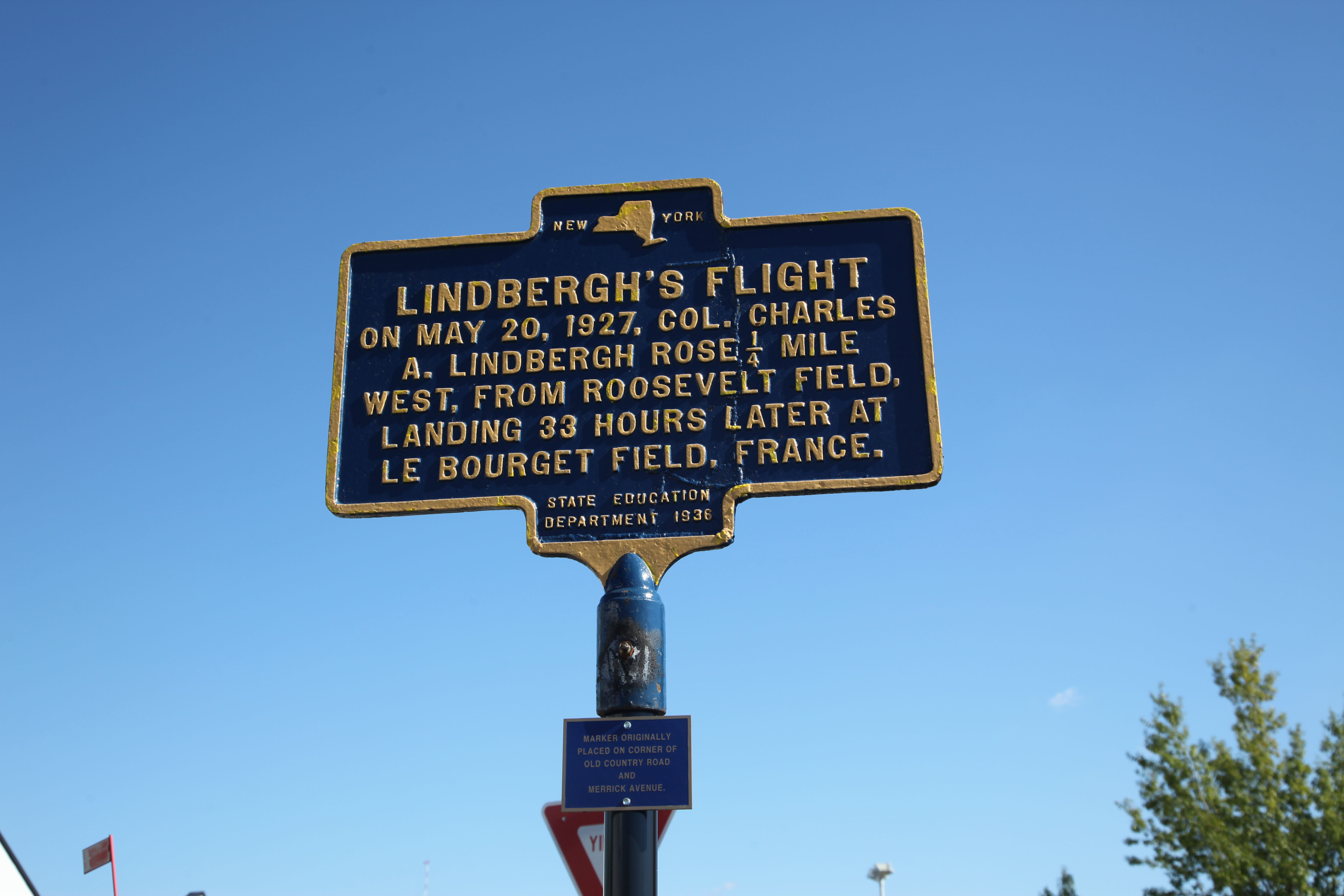
Several years ago, the historical marker was left at the door of the Cradle of Aviation in East Garden City. It has been restored and now is in place in the museum's parking lot.
Kleiner's Korner (Documents submitted by Art Kleiner)
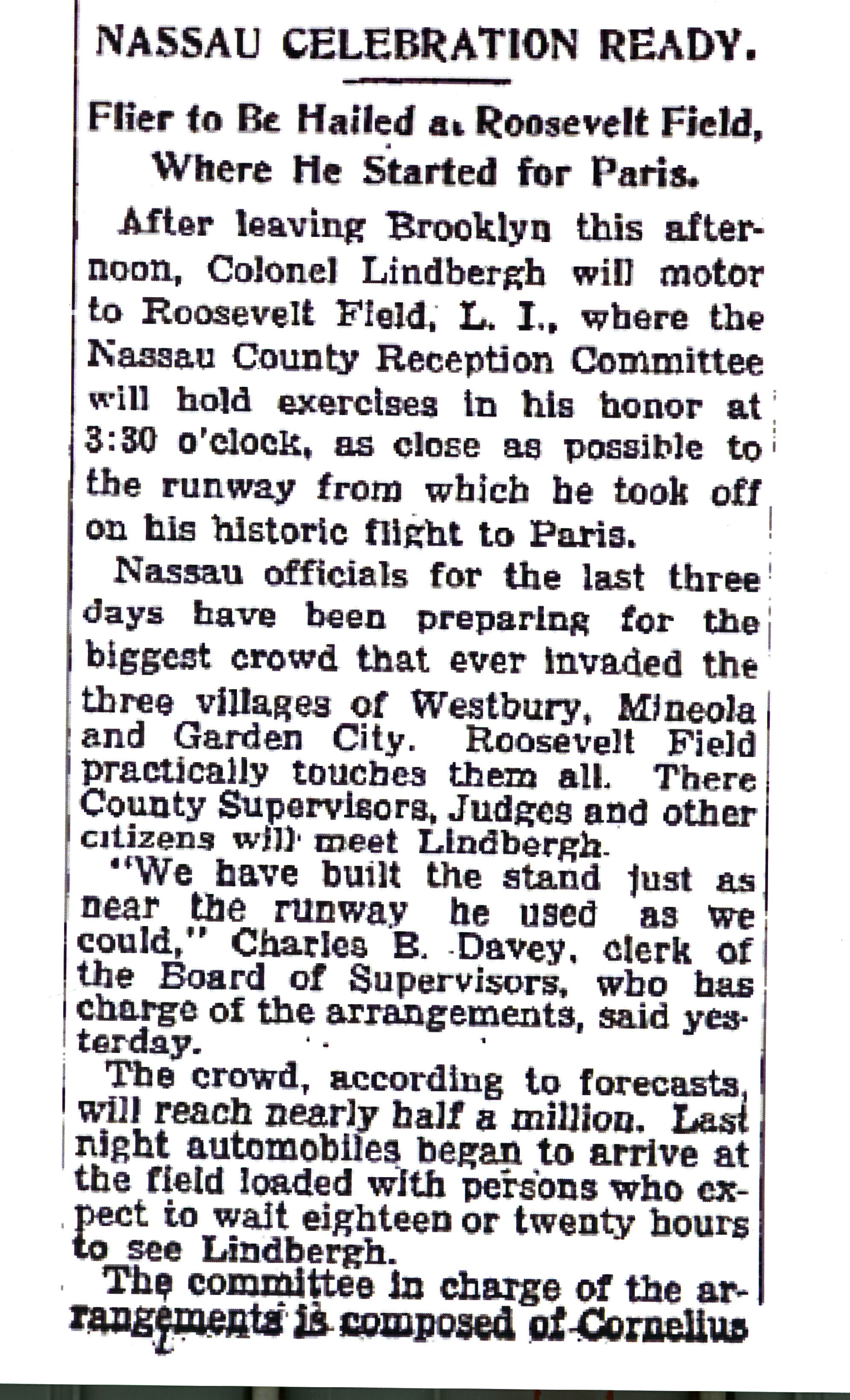
The New York Times, June 16, 1927
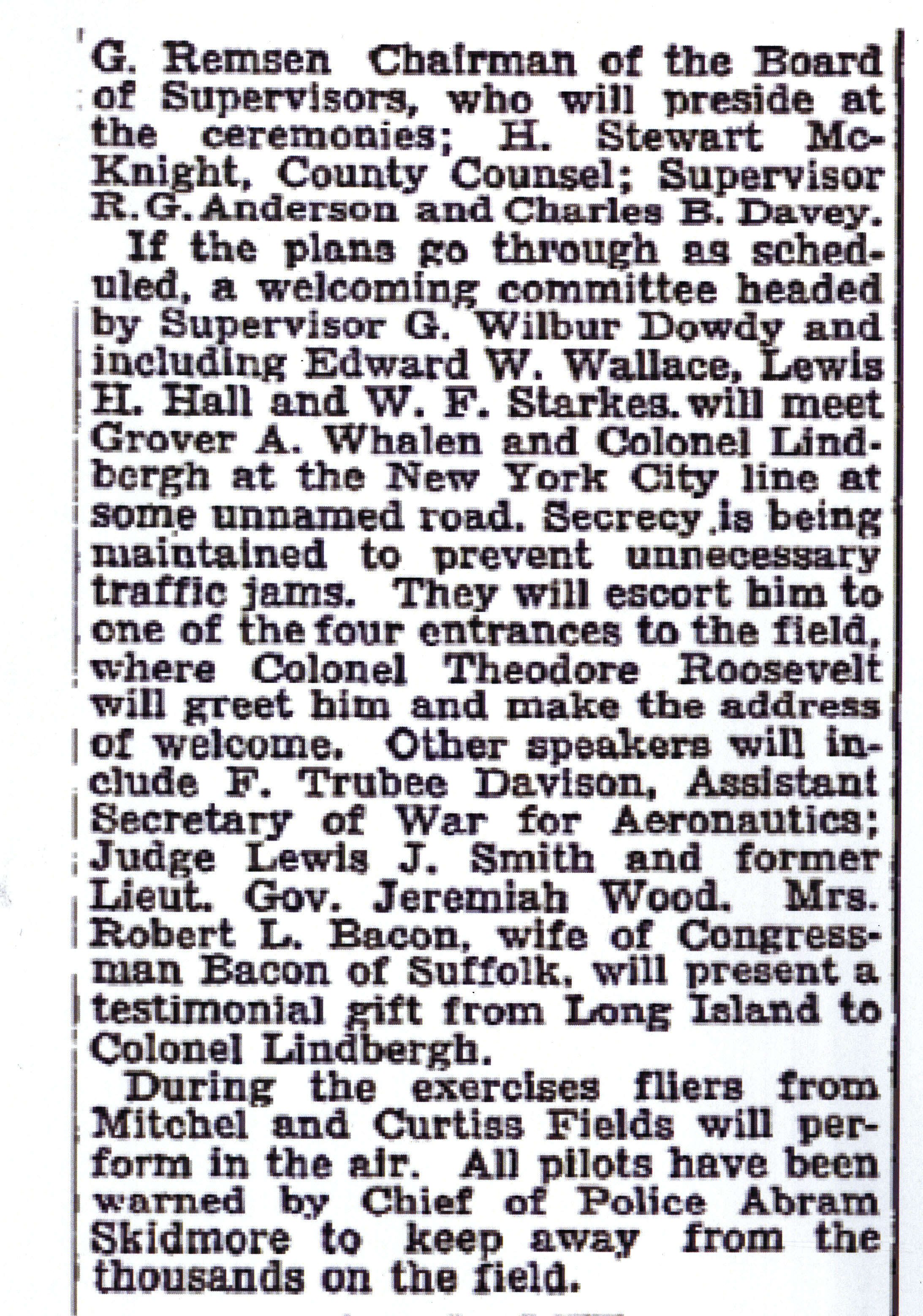
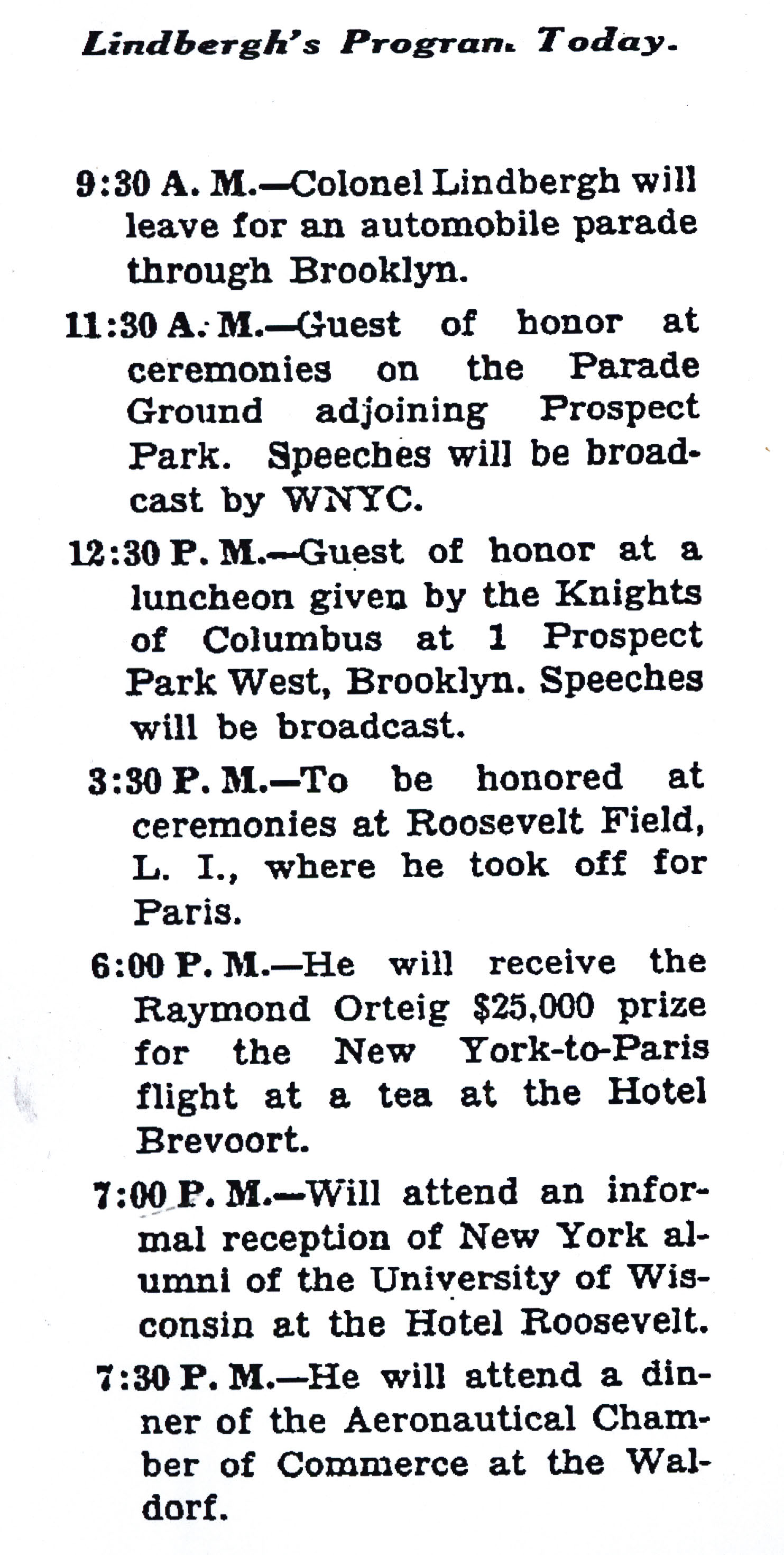

The New York Times, June 17, 1927
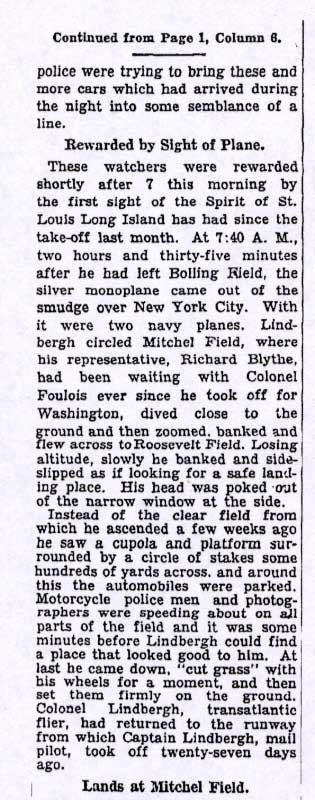
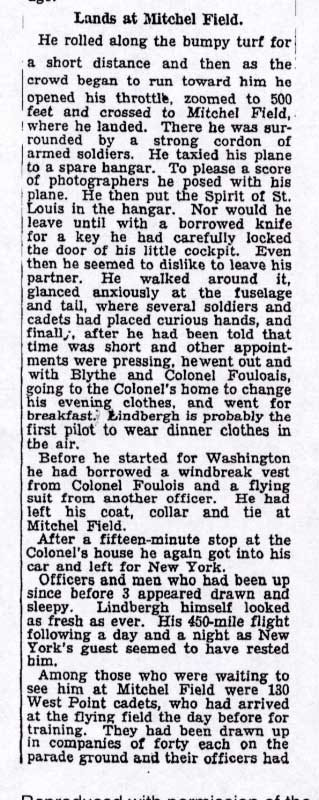
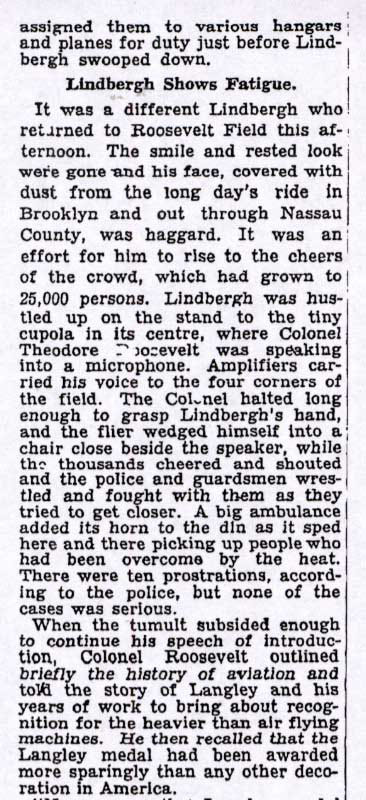
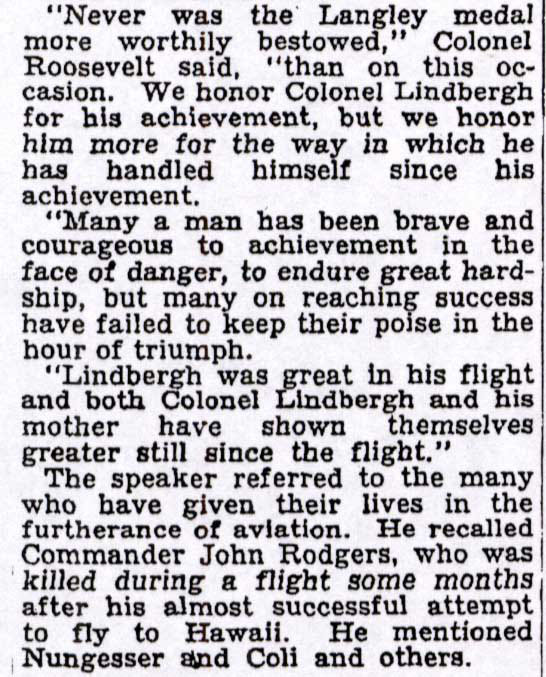
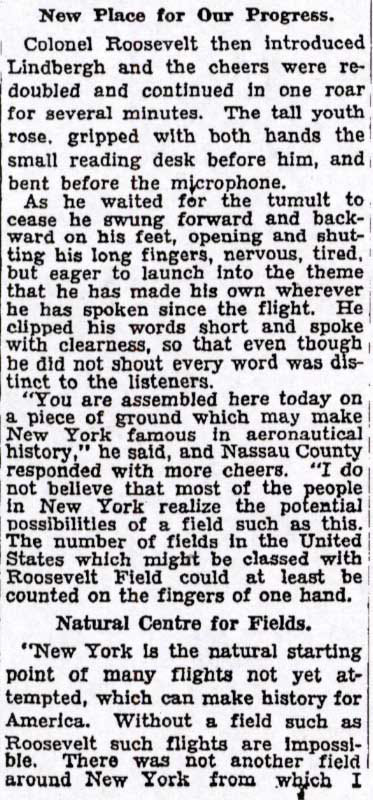
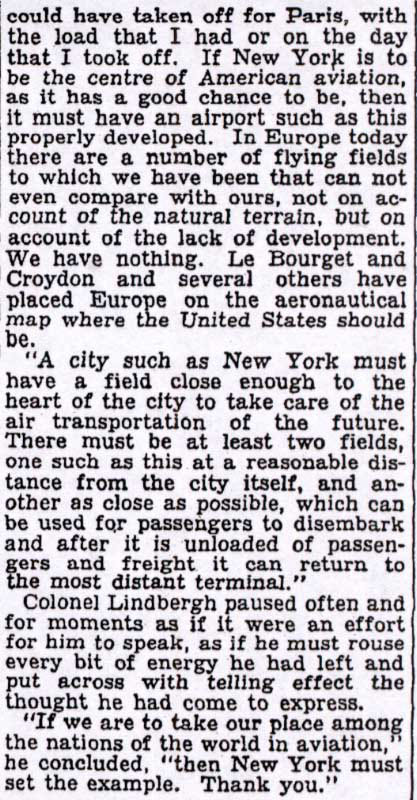
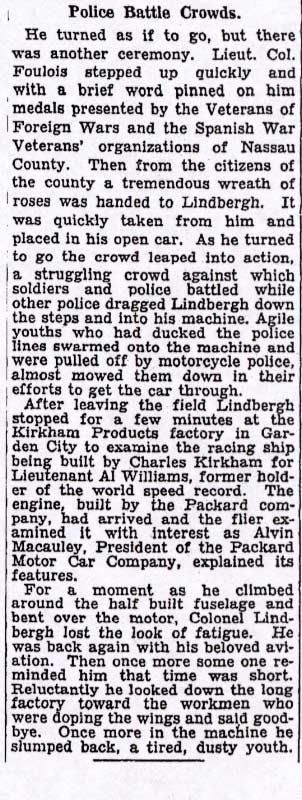

Comments
This photo shows the return of Charles Lindbergh to Roosevelt Field on June 16, 1927 to celebrate his successful solo flight across the Atlantic Ocean 3 weeks earlier. There appears to be a small piece of the LIMP in the lower right corner. Lindbergh was a frequent patron of the LIMP often using the entrance / exit at the Garden City Lodge. The golf course appears to be the Salisbury Links in the upper right portion of the photo.
June 16, 1927
Lindbergh’s return after his solo Atlantic flight
-What was the historic event captured in this aerial?
Charles Lindbergh returning to Roosevelt Field to celebrate his successful solo flight to Paris. Lindbergh had taken off from the Roosevelt Field east runway 27 days earlier.
-What was the date of the aerial?
June 16, 1927
-How was the Motor Parkway related to this photo?
The LIMP ran along the South edge of the field and probably one of the roads used to access the field.
-Which golf course can be seen in the aerial?
Salisbury Links
I remembered a blog entry from 2009 that provided most of the answers…
http://www.vanderbiltcupraces.com/blog/article/wednesday_august_12_2009_charles_lindbergh_and_the_motor_parkway_in_1927
The golf course was the Meadowbrook Golf Club (upper right)
The portion of roadway pictured, lower right, is the Motor Parkway.
Cars traveling to the reception in the circle exited Stewart Avenue and crossed the bridge over the Motor Parkway to eventually park in the circle.
I think this is Roosevelt Raceway Track which is also part of the Long Island Vanderbilt Motor Parkway and Possible the Golf Courser at Eisenhower Park /Salisbury Park not sure just guessing.
I’m going to go with Lindburgh’s departure for his famous non-stop trans-Atlantic flight. Or maybe it was his return. With that many cars… it was probably his return. It was Quentin Roosevelt field and the LIMP ran right past.
Lindbergh’s return to Roosevelt Field (or is that Mitchel?). June 12{?}, 1927. LIMP in upper left corner{?}. Not a golf course expert. Sam, III
Charles Lindbergh’s return to Roosevelt Field after crossing the Atlantic
June 16, 1927
The highest ? traffic day ever for the Motor Parkway, which ran to the south of Roosevelt Field.
Salisbury Club (now Eisenhower Park)?
Howard, see the “Kleiner’s Korner” articles I’m forwarding to you concerning the event.
What was the historic event captured in this aerial?
Return of Charles Lindbergh to Roosevelt Field 27 days after his solo flight to Paris.
-What was the date of the aerial?
June 16, 1927
-How was the Motor Parkway related to this photo?
Cars on the bottom part of photo on the southern border of the Motor Parkway.
-Which golf course can be seen in the aerial?
Intercollegiate Golf Course, later known as the Old Westbury Golf Club.
The mystery photo: Lindberg’s return from his flight to Paris, France in 1927.
The bridge over LIMP to get to the ceremony. The cars to view the event make up the circle seen.
What church is in the background ?
____________________________________
From Howard Kroplick
St. Brigid’s Catholic Church, 81 Post Avenue, Westbury
https://www.google.com/maps/place/St+Brigids+Catholic+Church/@40.7509382,-73.5877433,3a,90y,90h,90t/data=!3m4!1e1!3m2!1sE3TyPogx6_7lB0Nb84XpHg!2e0!4m2!3m1!1s0x0:0x97cf0f9b03d00587!6m1!1e1
From Bruce Adams:
Before Lindbergh even came into the picture in 1927:
Numerous textbooks still hail Charles Lindbergh an American Hero, errantly citing him as the first person to fly across the Atlantic!
• The very first transatlantic flight took place in 1919 (Lindbergh had absolutely nothing to do with it), when Lieutenant Commander Albert C. Read flew the Lame Duck, a Navy Curtiss NC-4 single-pilot flying boat for this purpose. After several engine breakdowns and floating at sea, he made it from New York, USA, to Lisbon, Portugal.
• The very first nonstop transatlantic flight (1,890 miles) in a fixed-wing aircraft, was accomplished only 3 weeks later, in 1919, by Cpt. John Alcock and Lt. Arthur Brown, who flew from Newfoundland to England in a Vickers Night Bomber. (Lindbergh still had absolutely nothing to do with it.)[5-6]
• In 1924, Lt. Lowell H. Smith and Lt. Erik H. Nelson took off on a journey of 26,100 mile s on a round-the-world trip beginning and ending in Seattle, Washington.
• In 1926, Ramon Franco flew across the South Atlantic in a twin-engine flying boat from Spain to Buenos Aires, Argentina. He was hailed as the “Columbus of the Air” in Latin America but received little notice in North America.
• From 1919 to 1927, an additional 78 people successfully flew across the Atlantic before Lindbergh’s attempt—a total of 81 people successfully flew across the Atlantic before Lindbergh.
• Finally, on June 27, 1927—8 years after the first transatlantic flights, and after 81 other people had already flown across the Atlantic, some of them solo—Lindbergh made his famed Atlantic crossing. Flying the Spirit of St. Louis for 3,600 miles in 33 hours, he went from Long Island, New York, to Le Bourget, close to Paris, France.